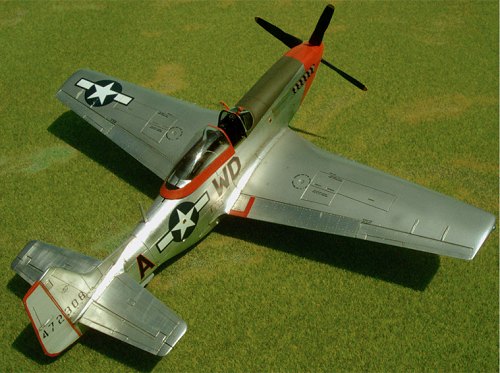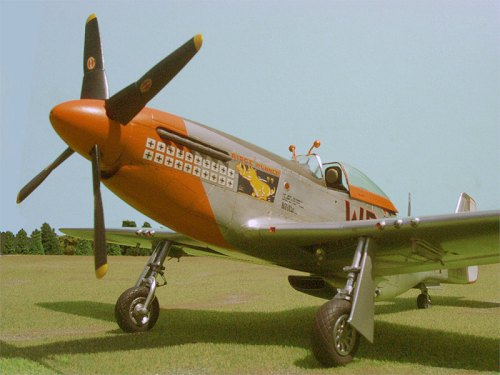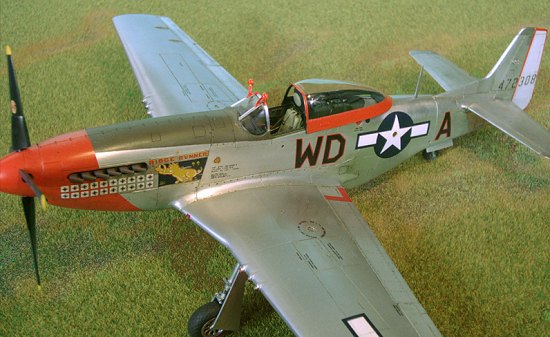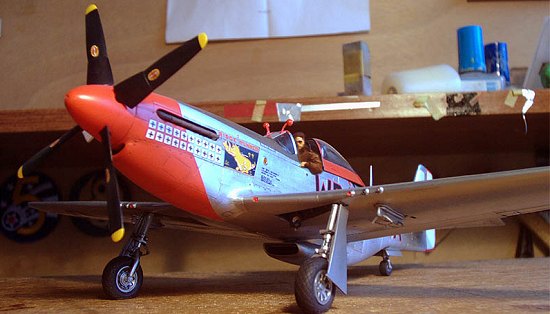
|
KIT: |
Tamiya 1/48 P-51D Mustang |
|
KIT # |
61040 |
|
PRICE: |
$26.00 MSRP |
|
DECALS: |
See review |
|
REVIEWER: |
Bucky Sheftall |
|
NOTES: |

|
INTRODUCTION |
This Tamiya 1/48 P-51D completes my foil “Victory Triptych” of the Big Three USAAF fighters.
As far as quality goes, Tamiya’s kit is still the jewel it was when I bought it in 1996. In fact, I was so intimidated by the pressure of wanting to do it justice that it sat near or at the top of my “Immediate To-do Pile” for the next eight years, taunting me every time it came into my field of vision (which was often, as it was right over my work table!). But I knew that I had to wait for the right combination of factors before I could start chopping sprue – i.e., good refs, great decals (in this case a potpourri of Cutting Edge CED 48113, Superscale stenciling and IPMS-USA 1999 sheet, thanks to Chris Bucholz), a nice Eduard PE set and a Squadron “Dallas” vac canopy.
However, most important of all was the right motivation package. Finishing my Bubbletop Jug in January, I was eager to do another foil job, and was also beginning to get some radical ideas about foil/Alclad II combinations after successful experiments on old models with this popular lacquer metalizer. The sublime moment of inspiration for building Ridge Runner III came when I was thumbing through Motorbooks’ “Fighter Command” while listening to the “Best Years of Our Lives” soundtrack (highly recommended for WW2 modeling, btw). Turning a page, I came upon the large shot of McKennon gunning RRIII’s engine for the cameraman just as my CD hit the dramatic “End Title” music (in the film, right where Dana Andrews kisses Teresa Wright at Homer’s wedding). And that, as they say, was that.
|
CONSTRUCTION |
 I used the Eduard P-51D PE set in conjunction with
Waldron placards and some scratched control knobs for the cockpit. Eduard
pre-painted seat harness belts were also used. Radio equipment was wired
up with hair-thin zinc wire twisted/bundled into cable and painted light
gray. The wiring eventually leads back to the radio frequency selector on
the port cockpit wall, though this is nearly impossible to see in the
photos I have provided with this article.
I used the Eduard P-51D PE set in conjunction with
Waldron placards and some scratched control knobs for the cockpit. Eduard
pre-painted seat harness belts were also used. Radio equipment was wired
up with hair-thin zinc wire twisted/bundled into cable and painted light
gray. The wiring eventually leads back to the radio frequency selector on
the port cockpit wall, though this is nearly impossible to see in the
photos I have provided with this article.
Converting the Tamiya kit to the specs of McKennon’s mount required some selective chopping and/or filling. Biggest pain-in-the-you-know-what was puttying the panel lines on the wings prior to painting them silver, as per North American Aviation policy ca. early 1945, when RRIII was manufactured. The idea of puttying over perfectly good panel lines set off all kinds of mental alarm bells for this modeler, but facts and photographic evidence won out over instinct in the end. Still, the process did involve something of a leap of faith.
Other RRIII requirements included removing the small cooling duct on the fuselage near the starboard wing fillet (an operation required for all WW2-era ‘Stangs), and fairing over the perforated carburetor cooling vents in the lower cowling (a nasty little exercise in frustration that could have been made much easier by following Tony Bell’s suggestion to drill the holes through before filling, in order to let trapped air out the back).
Other scratched items include AN/AP-13 rear warning radar made with zinc wire stripped from old electrical cord and twin “Spitfire” rearview mirrors from the spares box (in this case, modified mirrors from Tamiya Jugs faced with Waldron-punched foil discs). The formation lights found on the occasional European Theater Mustang in 1945 were represented with dial faces from the Eduard WWI instruments set and more punched foil discs covered over with punched Tamiya Clear Orange-tinted decal film. The Kit machine guns and fairings were replaced with telescoped brass microtubing. The wheels were “sagged” slightly with heat and sanding.
 The Squadron canopy is a
beautiful little piece of vacforming, and from the start I knew I wanted
to use the rear section. However, preliminary test-fitting showed that
the Squadron front canopy section – which I had initially shied away from
in favor of the kit part– was definitely doable. One obstacle here is
that the depth of the “trough” where the instrument panel cover meets the
fuselage canopy line is cut to accommodate the relatively thick kit piece
rather than thin vac-formed vinyl. I got around this problem by lining
the bottom of the trough with 0.3mm solder wire painted black. It
provided a perfect backing to push the lower canopy edge flush up against
the fuselage.
The Squadron canopy is a
beautiful little piece of vacforming, and from the start I knew I wanted
to use the rear section. However, preliminary test-fitting showed that
the Squadron front canopy section – which I had initially shied away from
in favor of the kit part– was definitely doable. One obstacle here is
that the depth of the “trough” where the instrument panel cover meets the
fuselage canopy line is cut to accommodate the relatively thick kit piece
rather than thin vac-formed vinyl. I got around this problem by lining
the bottom of the trough with 0.3mm solder wire painted black. It
provided a perfect backing to push the lower canopy edge flush up against
the fuselage.
Scale thickness for the aft edge of this piece was achieved by several layers of black electricians tape cut into thin strips. Inside canopy frame was colored with cut strips of black decal. This was repeated for the forward edge and internal framework of the rear canopy section. One problem I ran into with the rear section was that the black tape facing on the inner frame showed right through the “Debden Red” decal strip I wanted to use to cover the outside frame. The solution, I surmised, would have to involve something completely opaque, yet close enough to white not to compromise the nice red of the decal material. Answer? When in doubt, whip the foil roll out! The front canopy was glued in place with 30-minute epoxy, while the rear section is resting on the slide rails (nice Eduard pieces), with no use of adhesive. Before foiling, the fuselage was riveted using my watch gear ponce wheel.
|
COLORS & MARKINGS |
As RRIII, like all NMF ‘Stangs, involves a fairly
large anti-glare section, I decided to spray the OD lacquer (Gunze 12)
directly on to the plastic before foiling and Future’ing rather than
risking too much painting over bare foil on this critical area (paint
over foil, even with a good Future primer, is fragile at best). First, I
masked right up to the edges of the as-of-yet-imaginary line where the OD
would meet NMF on the finished model. This provided me with a foiling
guide. After foil was applied, I cut carefully along this line, then
peeled back the tape and burnished the foil edge down as hard as I could
without damaging the plastic. Later, when it was time to paint the OD, I
masked with very weak tack, transparent vinyl artist’s masking material,
again laying the tape right up to the edge of what would soon – hopefully
– be the OD anti-glare section. If your masking material is transparent
or at least sufficiently translucent to distinguish bare foil from
plastic under the tape, this job is not as
 difficult as it sounds. If you
must err here, err on the side of overspray on the foil, for when the
spray job is done, all you need to do to get a nice clean division
between the OD and NMF is to run the edge of a toothpick (or even your
fingernail) along the un-Futured, over-sprayed foil and the paint sloughs
right off.
difficult as it sounds. If you
must err here, err on the side of overspray on the foil, for when the
spray job is done, all you need to do to get a nice clean division
between the OD and NMF is to run the edge of a toothpick (or even your
fingernail) along the un-Futured, over-sprayed foil and the paint sloughs
right off.
In order to make my canopy framing decal material and, of course, to paint the famous 4th Fighter Group red nose, I stirred up a batch of “Debden Red” following Tom Cleaver’s tip on using Gunze Lacquer “Shine Red 79”, which I toned down very slightly with a drop of off-white in the airbrush mix. The cowling area was carefully masked with the above-mentioned weak tack tape and sprayed with Gunze Base White before laying on the red. Red-bordered white rudder was done with white paint and more Debden Red.
As Ridge Runner III only had a service life of a month or two (before McKennon’s squadron mate pranged it in a non-fatal but mechanically disastrous landing mishap), I chose to approach weathering on this model with a very, very light touch. In fact, the only panel-line darkening I did was some oil streaking around the engine area and wing fillet, and to accent working access hatches and control surfaces. Everything else was just left up to the reflective qualities of the foil, and in this case, as with my Jug, I found simple contrast of light and shadow was good enough without help from washes, etc. Blackening all of the panel lines on the model would have looked grossly overdone, and worst of all, unrealistic. Tail wheel area was hit up with heavily thinned Light Earth.
After puttying and buffing, the wings were painted with Alclad “White Aluminum”. A nice heavy application of Future gave this a sufficiently “silver-painted” quality to distinguish it from the NMF of the fuselage and control surfaces, again, just as on the real plane. All foiled areas were washed with soapy warm water and primed with Future prior to weathering and decaling.
 Alclad Polished Aluminum was used in areas I have
found problematic for foil (OK! So I cheated!), notably wing and both
horizontal and vertical stabilizer tips. I also found this prudent for
the ventral air scoop intake area, as well as for the curved section in
the vertical stabilizer fairing. Hardcore Alclad advocates who insist
that all we ever need for NMF can be had from a bottle will note the
noticeably darkened appearance of the Alclad-ded areas compared with
adjacent foil areas. To echo the old Bare Metal Foil ad for the
hundred-thousandth time, “nothing looks more like aluminum than…”
blah-blah-blah… Of course, crinkly, curling aluminum around a wingtip
looks like poo-poo, too, so we must sometimes search for the happy medium
– modeling, like life, being a series of compromises…
Alclad Polished Aluminum was used in areas I have
found problematic for foil (OK! So I cheated!), notably wing and both
horizontal and vertical stabilizer tips. I also found this prudent for
the ventral air scoop intake area, as well as for the curved section in
the vertical stabilizer fairing. Hardcore Alclad advocates who insist
that all we ever need for NMF can be had from a bottle will note the
noticeably darkened appearance of the Alclad-ded areas compared with
adjacent foil areas. To echo the old Bare Metal Foil ad for the
hundred-thousandth time, “nothing looks more like aluminum than…”
blah-blah-blah… Of course, crinkly, curling aluminum around a wingtip
looks like poo-poo, too, so we must sometimes search for the happy medium
– modeling, like life, being a series of compromises…
Last major painting operation was to give the entire airframe a final light overspray of matte clear to tone down the crassest excesses of the aluminum glare before setting the rear canopy down on the slide rails and calling it a day.
Photography
Photos were taken with my Casio QV-2100, with the model in my “Wauchop Box” and illuminated by sunlight.
Pix were darkened and yellowed slightly in Photoshop to simulate the effect of the aged Kodachrome photographs of RRIII in Fighter Command.
|
REFERENCES |
P-51 Walkaround (Walkaround Number 7) Squadron/Signal Books
Fighter Command by Jeffrey L. Ethell and Robert T. Sand, Motorbooks.
Aero Detail 13: North American P-51 Mustang, Dai Nippon Kaiga Books
In closing, I would like to thank everyone, in addition to those mentioned here by name, who gave help and valued advice during this project.
May 2004
If you would like your product reviewed fairly and quickly by a site that has over 250,000 visitors a month, please contact me or see other details in the Note to Contributors.